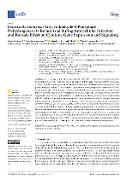Francisella tularensis Glyceraldehyde-3-Phosphate Dehydrogenase Is Relocalized during Intracellular Infection and Reveals Effect on Cytokine Gene Expression and Signaling

Autor
Pávková, Ivona
Kopečková, Monika
Link, Marek
Vlčák, Erik
Filimonenko, Vlada
Lecová, Lenka
Žáková, Jitka
Lásková, Pavlína
Sheshko, Valeria
Stulík, Jiří
Datum vydání
2023Publikováno v
CellsRočník / Číslo vydání
12 (4)ISBN / ISSN
ISSN: 2073-4409Metadata
Zobrazit celý záznamTato publikace má vydavatelskou verzi s DOI 10.3390/cells12040607
Abstrakt
Glyceraldehyde-3-phosphate dehydrogenase (GAPDH) is known for its multifunctionality in several pathogenic bacteria. Our previously reported data suggest that the GAPDH homologue of Francisella tularensis, GapA, might also be involved in other processes beyond metabolism. In the present study, we explored GapA's potential implication in pathogenic processes at the host cell level. Using immunoelectron microscopy, we demonstrated the localization of this bacterial protein inside infected macrophages and its peripheral distribution in bacterial cells increasing with infection time. A quantitative proteomic approach based on stable isotope labeling of amino acids in cell culture (SILAC) combined with pull-down assay enabled the identification of several of GapA's potential interacting partners within the host cell proteome. Two of these partners were further confirmed by alternative methods. We also investigated the impact of gapA deletion on the transcription of selected cytokine genes and the activation of the main signaling pathways. Our results show that Delta gapA-induced transcription of genes encoding several cytokines whose expressions were not affected in cells infected with a fully virulent wild-type strain. That might be caused, at least in part, by the detected differences in ERK/MAPK signaling activation. The experimental observations together demonstrate that the F. tularensis GAPDH homologue is directly implicated in multiple host cellular processes and, thereby, that it participates in several molecular mechanisms of pathogenesis.
Klíčová slova
multitasking, pleiotropy, Francisella, glyceraldehyde-3-phosphate dehydrogenase, infection, secretion, interacting partners
Trvalý odkaz
https://hdl.handle.net/20.500.14178/2135Licence
Licence pro užití plného textu výsledku: Creative Commons Uveďte původ 4.0 International







